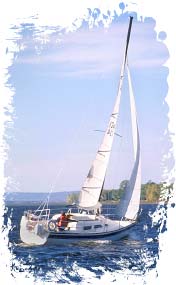The shape of the sail and the hull of the boat are the major factors that have allowed sailboats to more closely approach the ability of sailing upwind. In the early years of sailing ships, the European ships had a square sail design. This design only allowed for sailing with a favorable wind ('before the wind, or wind on the quarter'). With trade expanding into the East, Europeans were exposed to triangular sails in use on small boats in the orient. It was observed that these triangular sails allowed for navigation using a half wind (wind at 90 degrees to the boat), which further increased the ship's maneuvering ability ' particularly in port, where ships previously were 'dead in the water' without a favorable wind. European vessels incorporated the triangular sails fore and aft of the mainsails for the purpose of navigating out to sea to catch the favorable trade winds for the square sails to utilize.
The use of triangular sails caught on as the sail shape of choice as other benefits to the design were realized. By using a triangular sail design and centerboard (overdeveloped keel), it was possible to travel against the wind using a technique known as tacking.
Tacking allows the boat to travel forward with a wind at right angles to the boat. The boat travels for a time at an angle toward its desired course (to the right for instance), then the captain swings the boom of the sail and tacts back across the desired course at an angle to the left in a zig-zag fashion. In this way, tacking allows the boat to use prevailing wind from many other angles than in earlier sailing methods.
Since the boat is dependent on the wind for propulsion, the strength of the wind and the area of the sail used to catch the wind obviously play a part ' but how does a wind at right angles to the boat allow the boat to move forward?
This is accomplished with a bit of vector mathematics. The wind is the large force vector in the equation. As the wind pushes at approximate right angles to the boat, the boat's large keel (underwater wing shaped centerboard), poses a very large drag force against the boat being pushed in the direction of the wind. Since the keel is aligned with the length of the boat, the boat really wants to travel forward, and the resultant thrust vector is in that direction.
The shape of the sail also provides forward thrust. As the triangular sail inflates with a wind it creates an airfoil shape. As subsequent wind passes around the sail (airfoil), negative pressure is induced out front of and on the leeward side of the sail. This in turn causes surrounding air to rush into the sail and propel the boat further. This sail/airfoil action is compounded, as the boat travels faster, the wind around the sail creates more negative pressure, causing the boat to travel faster causing more negative pressure and so forth.
Answered by: Stephen Portz, Technology Teacher, Space Coast Middle School, FL

No comments:
Post a Comment